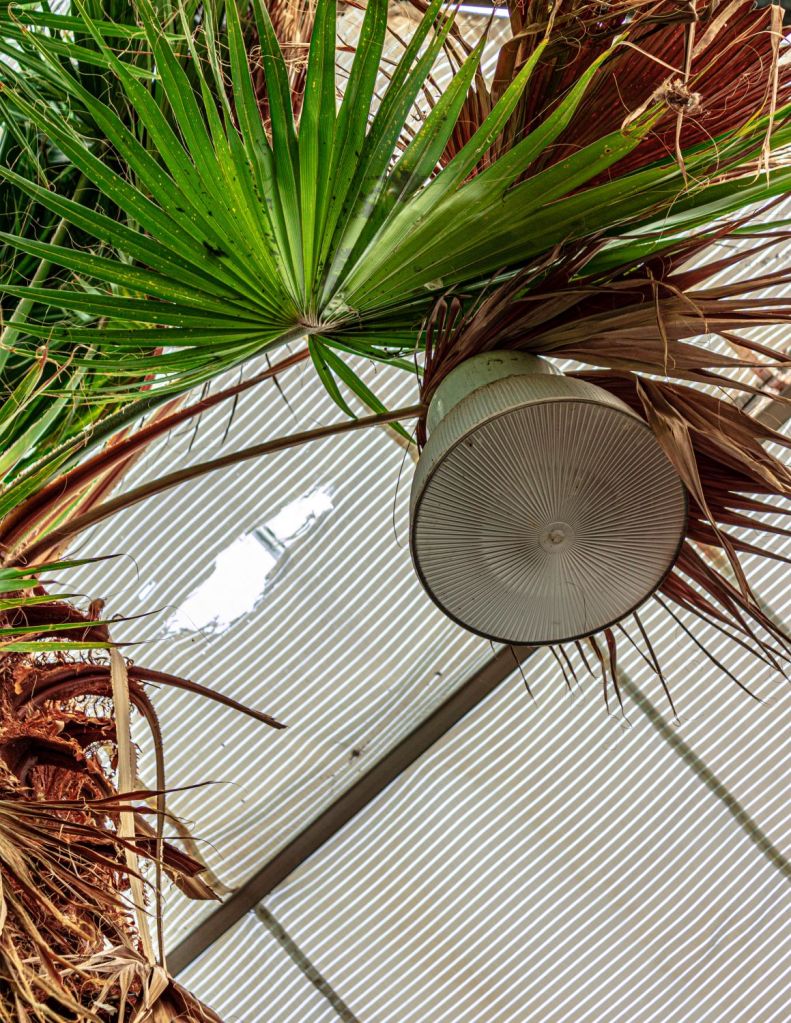


While researching this project, I spent a good amount of time at the Conservatory Greenhouse and the Bovey Greenhouse on the west side of campus. I also explored two commercial greenhouse nurseries in the region that were better maintained than the Conservatory greenhouse. At first, I thought I would reference my project back to the history of the Guelph University greenhouses. The plants that are now housed in the Bovey greenhouse used to be housed in greenhouses that were part of the Conservatory greenhouse complex and gardens. These greenhouses were taken away to make room for the GO bus station on campus. I thought that it might be interesting to show the juxtaposition between the “natural” greenhouses and how they were replaced with a bus station. My thoughts kept going to how the contents of greenhouses are unnatural. Without the greenhouse, the tropical plants that are housed within would all die in the region’s climate. The greenhouse’s main purpose is to provide these plants an environment in which they can live. Human intervention is required to design and build the greenhouse, pick the plants for the greenhouse, plant them and care for them. Based on this rationale and train of thought, I decided to create a series of portraits that showed this relationship between greenhouses and plants, equally showcasing the living organisms and the apparatus supporting them.
For in-process crit I presented eight shots all taken at the Conservatory greenhouse. While the other greenhouses I visited were “prettier” and better maintained, there was a grittiness in the ill-maintained Conservatory greenhouse that I thought added aesthetic interest and texture to the images. There also seems to be a wildness and merging of the plants with the Conservatory greenhouse where the plants have not been pruned and controlled. The plants have ripped through the shade-cloth ceilings, grown around lights and plastered themselves against windows creating sometimes abstract compositions. The Conservatory greenhouse shows the plants and greenhouse becoming one, making it difficult to separate the architecture from the plant life. After the in-process crit, feedback provided narrowed down my final photos to focusing on the abstract images that resulted from focusing on the plant growing around the greenhouse light fixture.
For my final photos, I chose to do a triptych showing the interaction between living plants and the light fixture from different angles, producing a series of abstract forms that make it difficult to separate the living from the man-made objects. The angles also brought a certain personality to the light fixture that a viewer might interpret as being “viewed” back by the subject of the photo.
In terms of composition, I went against typical plant photography and showcased both elements of the greenhouse and the plants equally in the same frame. I purposely did not attempt to show the complete plant in the frame as I wanted to show how large the subject was and create mystery as to what the rest might look like. The central focus of the photos is the light fixture or “eye” of the subject, while still keeping the background lines of the shade cloth and structural elements of the greenhouse in focus, to show the relationship between the two.
For lighting, I used natural light as I wanted the light to be similar to what you would experience in the greenhouse. I did some brightness and colour correction in Photoshop. Since I took the photos on different days, some sunny and some cloudy, I also did some colour corrections to help unify the lighting/colours across the series of three photos.
I experimented with printing these photos on several different types of materials including glossy paper, matte paper, translucent vellum paper and see-through acetate. I was considering whether it would add to the effect of mimicking looking through greenhouse windows and allowing things to be backlit as you would see plants in a greenhouse. In the end, I think the printing on matte paper was the most successful, otherwise the glare/reflection in the photos competes with and distracts from viewing experience.
In terms of scale, I decided to have all photos printed at 17×22 inches which was the largest I could go on available matte papers while still keeping sharp details. I wanted the subject of the photos to come across as large and expanding far beyond the photo and for this reason chose to have no border.
I was highly committed to this project and have 200+ photos that I shot to choose from for the three compositions. I worked several hours each week on visiting greenhouses and observing, shooting photos, adjusting chosen photos with Photoshop to get the look I was working towards and test printing on different papers.
For this project I did not sketch but worked closely with existing layouts/compositions at the greenhouse.